

University of Perugia
The charter for a Studium Generale in Perugia was drawn up in 1306 and approved by Pope Clement V in 1308. The various faculties of the Studium seem to have been housed in different locations until 1483, when Pope Sixtus IV ordered their consolidation. The palace that became known as the Palazzo dell' Università Vecchia was therefore built in Piazza del Sopramura (now Piazza Matteotti).
Two residential colleges opened in the 14th and early 15th centuries for students of the Studium:
-
✴the Collegio di San Gregorio; and
-
✴the Collegio di S. Girolamo.
Angelo Geraldini, who studied law at the Studium of Perugia, then became its rector and its first non-Perugian Professor of Law (1444-6). He also served as rector of both the Collegio di San Gregorio and the Collegio di San Girolamo. It was during his tenure that these two colleges took on the titles of (respectively) Sapienza Vecchia and Sapienza Nuova.
A number of new colleges were established in the 16th century, including:
-
✴Sapienza Bartolina (1571), instituted by Marcantonio Bartolini; and
-
✴Sapienza Oradina (1572-82), instituted by Giulio Oradini.
These colleges are described in turn below.
Sapienza Vecchia (1362)
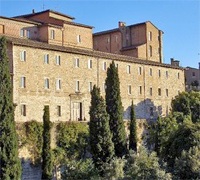
Cardinal Nicolò Capocci, who studied law at the ancient Studium, founded this college, which was known initially as the Collegio di San Gregorio, for the maintenance of 40 poor theology students. He seems originally to have intended to house it in Palazzo Capocci, but subsequently secured a site for it in Via della Cupa, just inside the ancient city wall. Pope Gregory XI granted it recognition in 1371, and it became, in effect, the theological faculty of the Studium. The Sapienza Vecchia was suppressed in 1797, and part of the building was used as a theatre known as the Teatro della Minerva. It re-opened in 1802 but closed again in 1811, when the buildings passed to the University. The Collegio Pio della Sapienza (originally the Sapienza Nuova, see below) moved here in 1829. In 1902, it passed to the Fondazione ONAOSI (Opera Nazionale per l'Assistenza agli Orfani dei Sanitari Italiani) and still operates as a female orphanage and (since 1977) as a residence for female students.
The theatre, which was rebuilt in 1814 as the Teatro della Sapienza, has been recently restored. [Entrance at number 6, Via della Sapienza]
The receptionist of ONAOSI will show you the old Cappella di San Gregorio and (through a window on the way) the inner courtyard. The red and white stone curb of the well (1363-9) at its centre is original. while the surrounding colonnade was added in 1596.
Cappella di San Gregorio
Frescoes (14th century)
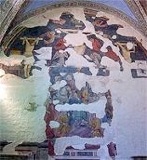
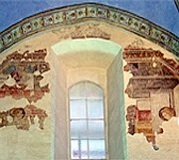
Crucifixion, on the altar wall Annunciation, on the right wall
These damaged frescoes were re-discovered recently under the plaster.
Art from the Chapel
Madonna della Pergolata (1446-7)
As set out below, this altarpiece might have been commissioned for the Sapienza Vecchia or (more probably) the Sapienza Nuova.
Sapienza Vecchia Altarpiece (1518)
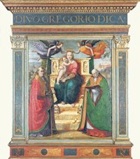
Sapienza Nuova (1427: demolished 1540)
Bishop Benedetto Guidalotti of Recanati bought the Albergo del Leone in 1427 to provide premises for a new college, the Collegio di S. Girolamo for impecunious foreigners who wished to study law and medicine the Studium. He died in 1429, and Pope Martin V appointed Cardinal Antonio Cassino to complete the foundation of the college. Pope Eugenius IV formally recognised it in 1431 and the first twenty students were in residence by 1443.
Alberto Guidalotti, Benedetto's father, who had taught civil law at the Studium, had been the only senior member of the family to escape the retribution that followed the murder of Biordo Michelotti by Francesco Guidalotti in 1398. Benedetto had nevertheless found it prudent to develop his career at the papal court, becoming Treasurer to Martin V. The establishment of the new college was part of a program to rehabilitate his family's reputation after his return from what had, in effect, been a period of self-imposed exile.
Bishop Guidalotti's sister, Elisabetta, whose father-in-law Onofrio Bartolini had taught civil law at the Studium in the period 1396-1404, took over the quest to rehabilitate the Guidalotti family. She is documented among the donors to the Sapienza Nuova after her brother’s death and was named in its statutes as the only woman allowed to enter its chapel.
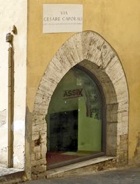
The Sapienza Bartolina (below), which became associated with the Sapienza Nuova after its formation in 1571, was housed in another part of the ex-convent that is now known as now Casa Moretti-Caselli (below).
At sometime after 1576, the college acquired the small church of to SS Stefano e Biagio.
The college owned the parish church of Sant’ Isidoro by 1780-6, and objected (strongly but without effect) when Palazzo Donini Nuovo was built behind it, necessitating the demolition of its campanile.
The French suppressed the Sapienza Nuova in 1798, but Pope Pius VII reopened it in 1807 as the Collegio Pio della Sapienza. It became part of the University in 1811. In 1824, Pope Leo XII made it the chief college of the university, and in 1829 it moved to the complex of Sapienza Vecchia (above). (The church of SS Stefano e Biagio was deconsecrated at this point.
Art from the Sapienza Nuova
Madonna della Pergolata (1446-7)
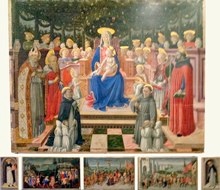
This important altarpiece is the earliest surviving work signed by Giovanni Boccati and one of the first altarpieces in Umbria with an undivided central field. The Confraternita di San Domenico bought the altarpiece at a very high price in 1446: their archives record that “Messer Angiolo”, who had originally commissioned it, no longer wanted it and adapted for use in the Oratorio di San Domenico.
Francesco Mancini (see the page on the artist) has suggested that “Messer Angiolo” was, in fact, Angelo Geraldini, who (as noted above) acted as rector of the Collegio di San Gregorio and of the Collegio di San Girolamo: it was probably at this time that they became known as (respectively) the Sapienza Vecchia and the Sapienza Nuova. SS Gregory and Jerome feature in the altarpiece, and it might have been intended for one of the college chapels. Another altarpiece of similar format was commissioned from Benozzo Gozzoli for the Sapienza Nuova in 1456 (see below).
The panel by Giovanni Boccati is now in the Galleria Nazionale. The main panel depicts the Madonna and Child with the Doctors of the Church (SS Ambrose, Jerome, Augustine and Gregory) and a choir of angels under a flowery pergola. In the foreground, SS Dominic and Francis commend four of the brothers: it seems likely that earlier figures were replaced by representations of the penitent members of the confraternity when they took over the commission from Messer Angiolo. (St Francis would still have been appropriate because the confraternity was closely associated with the Confraternita di San Francesco).
Sapienza Nuova Altarpiece (1456)
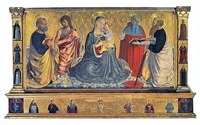
This altarpiece, which is signed by Benozzo Gozzoli and dated, was commissioned for the altar of the Cappella di San Girolamo of the Sapienza Nuova. The presence of the Guidalotti arms on the predella and of St Elizabeth among the depicted saints suggests that Elisabetta Guidalotti (above) commissioned the altarpiece. The college gave it to the Academia di Belle Arti, Perugia in 1816 and it is now in the Galleria Nazionale.
The main panel depicts the Madonna and Child seated on the ground in a meadow (an iconography known as the Madonna of Humility) against a gold background with SS Peter, John the Baptist, Jerome (to whom the chapel was dedicated), and Paul.
The predella depicts:
-
✴a central group of the Man of Sorrows with flanking half-length figures of the Virgin and St John the Evangelist;
-
✴half-length figures of SS Thomas Aquinas and Laurence to the left and SS Sebastian and Bernardino of Siena to the right; and
-
✴the Guidalotti arms at the extremes.
The other saints depicted on the sides of the frame are:
-
✴SS Dominic, Francis and Peter Martyr on the left; and
-
✴SS Catherine of Alexandria, Elizabeth of Hungary and Lucy on the right.
Sapienza Bartolina (1571)
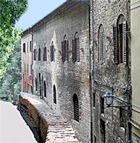
Like the other colleges, Sapienza Bartolina was suppressed in 1797. It re-opened in 1802 but closed again in 1811 when its activities transferred to the university.
Sapienza Oradina (1572-82)
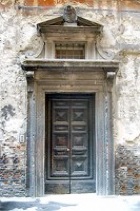
It moved to the building at number 34 Via Bartolo in 1760. The fine portal of the original building, which has the inscription “Collegium Oradinum” on its architrave, was moved to the new location.
Like the other colleges, Sapienza Oradina was suppressed in 1797.
Return to Monuments of Perugia.
Return to: Walk II (Sapienza Vecchia);
Walk V (Sapienza Oradina); or
Walk VII (Sapienza Nuova; Sapienza Bartolina).

